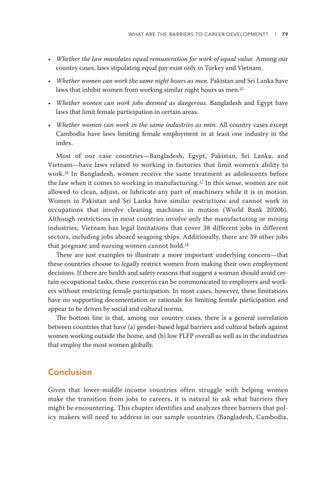What Are the Barriers to Career Development?
l
79
• Whether the law mandates equal remuneration for work of equal value. Among our country cases, laws stipulating equal pay exist only in Turkey and Vietnam. • Whether women can work the same night hours as men. Pakistan and Sri Lanka have laws that inhibit women from working similar night hours as men.15 • Whether women can work jobs deemed as dangerous. Bangladesh and Egypt have laws that limit female participation in certain areas. • Whether women can work in the same industries as men. All country cases except Cambodia have laws limiting female employment in at least one industry in the index. Most of our case countries—Bangladesh, Egypt, Pakistan, Sri Lanka, and Vietnam—have laws related to working in factories that limit women’s ability to work.16 In Bangladesh, women receive the same treatment as adolescents before the law when it comes to working in manufacturing.17 In this sense, women are not allowed to clean, adjust, or lubricate any part of machinery while it is in motion. Women in Pakistan and Sri Lanka have similar restrictions and cannot work in occupations that involve cleaning machines in motion (World Bank 2020b). Although restrictions in most countries involve only the manufacturing or mining industries, Vietnam has legal limitations that cover 38 different jobs in different sectors, including jobs aboard seagoing ships. Additionally, there are 39 other jobs that pregnant and nursing women cannot hold.18 These are just examples to illustrate a more important underlying concern—that these countries choose to legally restrict women from making their own employment decisions. If there are health and safety reasons that suggest a woman should avoid certain occupational tasks, these concerns can be communicated to employers and workers without restricting female participation. In most cases, however, these limitations have no supporting documentation or rationale for limiting female participation and appear to be driven by social and cultural norms. The bottom line is that, among our country cases, there is a general correlation between countries that have (a) gender-based legal barriers and cultural beliefs against women working outside the home, and (b) low FLFP overall as well as in the industries that employ the most women globally.
Conclusion Given that lower-middle-income countries often struggle with helping women make the transition from jobs to careers, it is natural to ask what barriers they might be encountering. This chapter identifies and analyzes three barriers that policy makers will need to address in our sample countries (Bangladesh, Cambodia,


